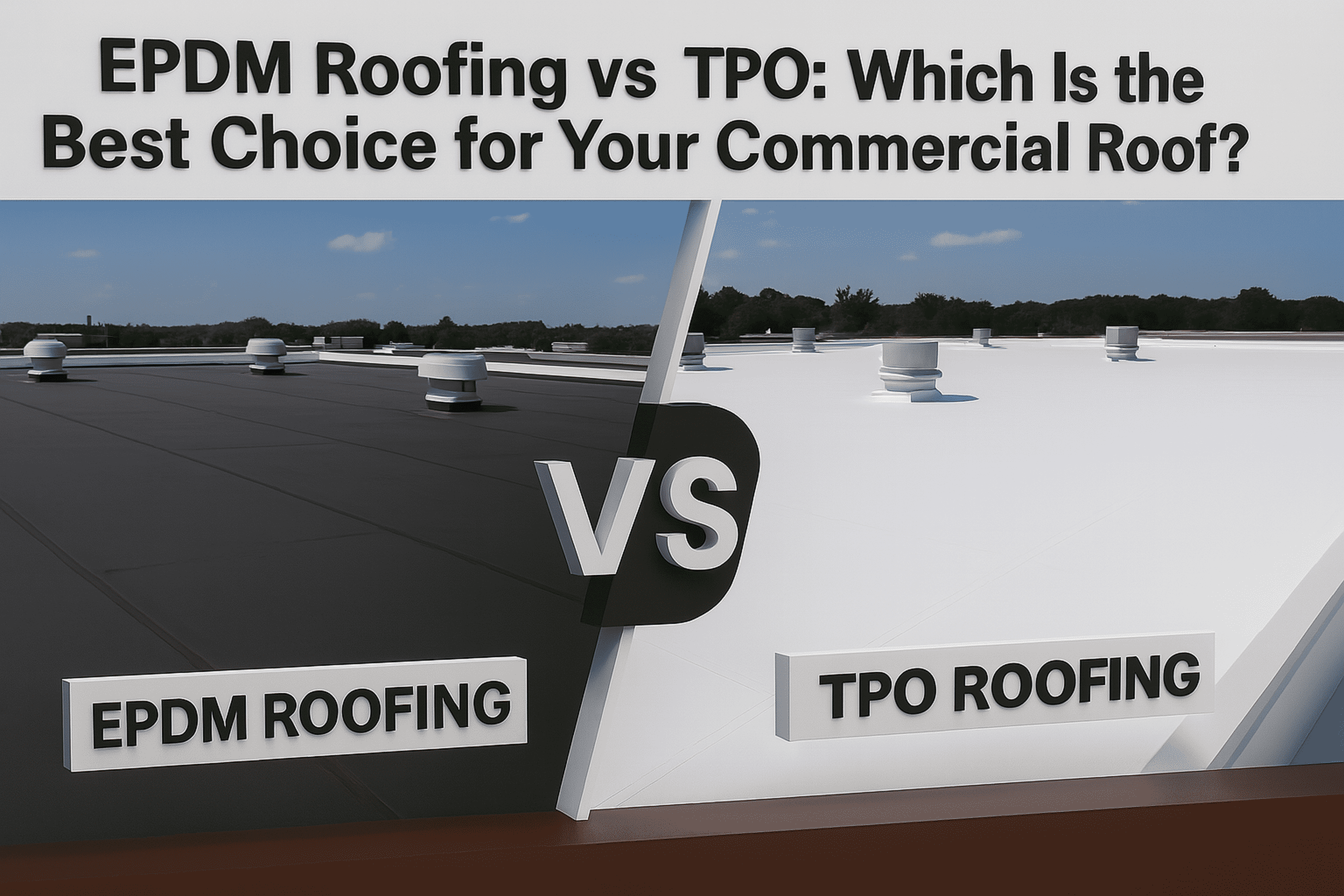
For commercial structures, flat-roofed systems are the preferred option because they are cheaper and more practical. When it comes to discussing the appropriate roofing material for a flat commercial roof, the conversation is always centered around EPDM roofing vs TPO. The two roofing choices will influence the building’s life, energy consumption, and maintenance costs.
Knowing the features, pros and cons, and differences between the two materials will help you make the right decision. Let’s see how EPDM roofing stacks up against TPO roofing.
What Is EPDM Roofing?
EPDM Roofing is a commercial roofing system based on EPDM roofing membranes, composed primarily of synthetic rubber. EPDM roofing systems are used in low-slope buildings and are renowned for their:
- Outstanding ultraviolet light exposure resistance
- High flexibility, including in colder regions
- Durable performance for 20-30 years
- High resistance to ozone, weathering and abrasion
EPDM is composed mostly of synthetic rubber, which is why it is usually available in the color black. The black color helps in heat absorption, thus making it suitable for regions with cold weather. EPDM roofing systems for commercial buildings are quite popular because of their low cost and ease of installation.
For additional roof durability in residential projects, many homeowners also explore advanced options like Fortified Roofing Services to strengthen homes against storms and hurricanes.
What Is TPO Roofing?
TPO (thermoplastic polyolefin) is a single-ply membrane designed to offer energy-efficient and reflective roofing. The TPO roofing system is distinguished by the following features:
- Heat-reflective, white-colored membrane
- It enhances energy efficiency, which reduces the need for cooling.
- Welded seams make it stronger, more flexible,
- and less likely to be damaged by UV radiation.
TPO roofing is often used on commercial buildings and works well in hot locations where the roof has to reflect light. People think it’s excellent for the environment, and you can put it up with or without mechanical fasteners.
The primary things that set EPDM and TPO roofing apart
Material Composition & Durability
The material that makes up EPDM roofing vs TPO roofing is the first notable distinction between the two:
- EPDM is a kind of synthetic rubber that can handle severe circumstances for a long period.
- TPO is a thermoplastic membrane that is designed to save energy and reflect light.
With good care, EPDM can last up to 30 years. TPO, on the other hand, usually lasts 20 to 25 years, depending on how well it is installed.
For projects where style and strength are essential, Metal Roofing Services offers a high-performance alternative to traditional flat roof materials.
Installation Process
- EPDM installation involves adhesive bonding and requires fewer seams, minimizing risk of leaks.
- TPO installation is heat-welded at the seams, making it watertight but requiring skilled labor.
TPO often requires more precise installation, which can increase labor costs and time.
Energy Efficiency
The performance difference between TPO and EPDM roofing is much clearer with their energy performance differences:
- Cooler climates benefit from EPDM roofing as it absorbs heat.
- Warmer climates benefit from TPO roofing as it reflects sunlight.
These differences should be considered along with your building’s energy objectives and local climate.
Cost Comparison
Knowing the EPDM roof cost and TPO roof cost helps evaluate your ROI.
- EPDM roofing has a lower cost.
- TPO roofing may cost more in energy-saving implementation, but savings over time may justify the expense.
So, in looking at EPDM roofing vs TPO, both are not just about cost but also the value offered in the roofing system chosen.
TPO Roofing Pros and Cons
Pros:
- Lightweight and flexible, TPO reflects heat.
- UV and ozone proof
- Trimble and seam-welding mitigate the risk of leaks.
Cons:
- Long-term performance history is limited.
- Seam-welding relies heavily on the skill of the installer, and poorly done seams run the risk of detaching.
The TPO roofing pros and cons need careful consideration in light of the intended use and location of the building.
Flat Roof Materials: Where Do EPDM & TPO Fit?
EPDM and TPO are two of the more popular flat roof materials today. Compared to options like PVC or built-up roofing, both EPDM and TPO are more affordable and long-lasting.
- EPDM roofing works best in colder climates that require high durability and lower initial cost.
- TPO roofing is best for hot climates that prioritize energy efficiency and reflectivity.
For a broader understanding of how expert installation improves performance, explore this detailed blog on Protecting Your Home with Expert Roofing Solutions.
Which Roofing System Is Right for You?
When choosing the best roofing material, several elements need to be considered:
- Climate: EPDM works best in colder climates, while TPO is better for warm, sunny regions.
- Building type: TPO may be better suited for larger commercial structures due to the reflectivity.
- Energy goals: TPO is more effective in reducing energy costs due to the HVAC in hot climates.
- Budget: TPO is usually more expensive, while EPDM is often cheaper to install but may not provide the energy savings.
When considering EPDM roofing vs TPO, think of these factors to decide what will best suit your commercial project.
Conclusion
EPDM and TPO roofing systems, to some extent, provide some of the best options based on your building’s geographic location, energy requirements, and budget. The primary difference between TPO and EPDM roofing is how each of them performs during the installation and in environmental conditions afterwards.
Professional insight will ensure that every decision made is the best one possible.
Are you in search of the perfect material for your business’s flat roof? Reach out to Sunbelt Roofs for unparalleled guidance and roofing services.
